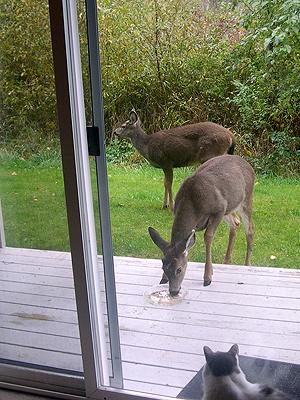Dying of Kidney Failure, Nine-Year-Old Sammy Is Shown Compassion by an Unexpected Friend
 |
| Sammy Is Comforted by a Deer Who Visited His Yard |
"The boundaries between humans and animals are becoming less and less clear. Thirty years ago, people thought humans and animals were very different from each other. No one thought animals used tools. No one thought they had any kind of culture. Those boundaries have been getting fuzzier and fuzzier."
-- Michael Krutzen, University of Zurich
As Margie Scott's nine-year-old gray and white longhaired cat Sammy lay dying of kidney failure last May, he nonetheless retained his lifelong longing for the great outdoors. Cruelly mutilated by Scott shortly after she had adopted him at the tender age of six-months, he had spent his entire life imprisoned indoors.
Since his race was all but run, she relented and allowed him to spend parts of his last days outside her Bellingham, Washington apartment. Since the apartment complex is surrounded by woods and wetlands, deer sometimes come around and one day she witnessed something truly extraordinary transpire between Sammy and a deer.
One of them moseyed up to him and they touched noses. Next, the deer started licking him around the head and neck and this continued for several minutes.
"I truly believe the deer was able to sense that there was something wrong with Sammy and that was why he started licking him, like he was trying to nurture him," Scott told Seattle's King5-TV on June 14, 2006. (See "Dying Cat Finds an Unlikely Friend.")
Sadly, Sammy crossed the Rainbow Bridge two days later.
This amazing event rekindles several old arguments concerning not only the remarkable sensitivity of animals but also their ability to empathize with other animals, man included. Because of their superior sensory organs, they are in tune with a much wider spectrum of the natural world than humans. In particular, sights, sounds, and smells that totally elude humans are an everyday part of their lives.
Empathy is a good deal more complicated, however, in that scientists normally make distinctions between it and its higher forms of sympathy and altruism. It is also distinguishable from misplaced nurturing instincts.
For instance, a three-year-old Dachshund named Emma from Rose Valley, Washington made headlines last summer when she adopted five four-week-old kittens. Meanwhile, in Bedford, Indiana, a Golden Retriever named Rosie at the White River Humane Society also took a kitten under her wing. (See Cat Defender post of July 17, 2006 entitled "Dachshund Named Emma Adopts Quintet of Feral Kittens That Her Mistress Cruelly Stole from Their Mother.")
In another case, Elsa, a Rottweiler from the London suburb of Luton, also adopted a homeless kitten. (See Cat Defender post of October 15, 2005 entitled "Elsa, a Rottweiler Feared in the 'Hood, Shows Her Soft Side by Adopting an Abandoned Kitten.")
 |
Sammy Watches as His New Friend Visits the Deck Outside |
There is also the story of Ginny, a Schnauzer-Siberian Husky mix from Long Beach on Long Island, who reportedly rescued more than eight-hundred abandoned and injured cats during her seventeen years on this earth. Since the circumstances surrounding the rescues are not known, it is not clear what label should be attached to Ginny's stellar behavior. (See Cat Defender posts of September 2, 2005 and November 17, 2005 entitled, respectively, "Ginny, a Dog Who Rescued Cats, Is Killed Off by Her Owner on Long Island" and "Westchester Cat Show to Celebrate the Life of a Dog Who Rescued Hundreds of Cats on Long Island.")
Although many animal lovers have long insisted that animals are not only capable of empathy but also of sympathy and even altruism, researchers up until recently have been reluctant to endorse that view. They have instead steadfastly held to the view that empathy is soley an attribute of man.
All of that changed in June of last year when a team of researchers led by Jeffrey Mogil of McGill University in Montreal released the results of a study that they claim proves that even mice are capable of empathy. More importantly, "If it's in the mouse it's probably in all mammals," Mogil told the Montreal Gazette on June 30th. (See "Mice Can Feel Empathy, McGill Study Reveals.")
Starting from the ludicrous premise that "you can't study pain without inflicting pain," Mogil and his team injected acetic acid into the bellies of lab mice and formalin into their paws. From this they discovered that the mice showed empathy for cagemates that they knew but not for those that they did not know. Mogil terms this rudimentary form of empathy an emotional contagion which is similar to contagious yawning in humans.
Unlike sympathy, which requires consciousness of another's suffering, the empathy displayed by the mice is instead a subconscious and automatic form that entails the communication of pain from one mouse to another.
Over the millenniums man has concocted various self-serving arguments that have asserted not only his superiority to the animals but also his right to kill and exploit them with impunity. The absurd notion that animals lack empathy now joins the earlier discredited argument that they do not feel pain.
Nonetheless, these findings have not stopped Mogel and other vivisectors from torturing, mutilating, and killing animals by the millions in their laboratories. Although it is the mark of an intelligent person to internalize newly acquired knowledge, scientists seldom do this; au contraire, their discoveries have a tendency only to make them even crueler in their relations with both man and animals and therefore contemptuous of all moral standards.
One by one man's claims to superiority over the animals are falling like dominoes. Up until recently the scientific community claimed that only man was capable of expressing grief and that this proved his superiority. It has now been proven, however, that elephants possess this capacity also and researchers in the future will no doubt discover that it exits in all animals. It may not manifest itself in quite the same way that it does in man but it will nonetheless be found to exist.
The argument that only man possesses self-consciousness has also fallen by the wayside now that orangutans at both the National Zoo in Washington and the Atlanta Zoo have been discovered grooming themselves in mirrors.
Animals also possess the ability to make and use tools. Researchers at Oxford have discovered that New Caledonian crows fashion tools out of leaves and twigs for use in searching for food. Chimpanzees, orangutans, and gorillas have also been recorded using primitive tools. For instance, a young gorilla in the Congo has been seen using rocks in order to crack open palm nuts. In other instances, gorillas have been recorded using sticks to test the depths of ponds and small tree trunks for both support and as bridges. (See Washington Post, October 3, 2005, "Wild Gorillas Seen Using Tools," and The Press of Atlantic City, October 19, 2005, "Congo Scientists Go Nuts Over Gorilla Using Tools.")
 |
| Was Allowed Outside During His Last Days |
Bottlenosed dolphins off Shark Bay in Australia have been observed using sponges in order to protect their delicate snouts from sharp coral and the stings of stonefish as they forage for food on the bottom of the ocean. Even more impressive was the discovery that female dolphins teach this tactic to their female offspring. (See Washington Post, June 27, 2005, " 'Sponging' Dolphin May Be Sharing Culture.")
Michael Noonan, a professor of animal behavior at Canisius College in Buffalo, has discovered that orcas not only use regurgitated fish in order to lure seagulls down to the water so that they can prey upon them, but that they teach this maneuver to other whales. (See Associated Press, September 2, 2005, "Clever Whale Uses Fish to Catch Seagulls.")
This discovery places dolphins and orcas in the same category as humans and primates as the only animals known to transmit behavior through interacting with each another. Chimps, for example, teach each other how to use sticks in order to get ants out of the ground and orangutans pass down unique eating habits, bedtime rituals, and other behavior.
Since scientists make a distinction between cultural learning and that which is either inherited or learned from mimicry, it is not clear which category geese and songbirds should be placed. Although geese teach their goslings the migration routes and songbirds instruct their fledglings in both how to sing and fly, it is not clear whether this type of learning comes from instruction or mimicry.
Noam Chomsky's celebrated theory that recursive grammar is a uniquely human attribute has also been discredited. For example, Tim Gentner of the University of California at San Diego has been able to teach grammar to starlings. (See San Francisco Chronicle, April 27, 2006, "Songbirds May Be Able to Learn Grammar.")
Moreover, scientists at the University of Edinburgh have discovered that the language of putty-nosed monkeys in Nigeria contains syntax. (See The Independent of London, May 18, 2006, " 'Pyow hack!' Monkeys Can Talk to Each Other Using Sentences.")
Animals also demonstrate a remarkable capacity to learn. For instance, an African Grey parrot named Alex can not only talk but also count, distinguish between colors, and identify forty different objects as well as fetch them on command from adjoining rooms. He is reportedly learning to read and may understand the concept of zero. (See World Science, July 6, 2005, "Researchers Explore Whether Parrot Has Concept of Zero.")
 |
| Sammy Was Such a Truly Handsome Cat |
A gorilla named Koko at the Gorilla Foundation in Woodside, California understands more than two-thousand spoken words and one-thousand hand gestures used in sign language. She also has an IQ of between seventy and ninety-five. Meanwhile, at the Max Planck Institute in Leipzig, a Border Collie named Rico understands two-hundred words.
On a more mundane level, researchers at Purdue have found that pigs crave affection and easily become depressed if they are not allowed playtime with their mates. It is also a widely observable phenomenon that kittens, puppies, bear cubs, mice, and other young mammals play together in much the same fashion as children.
The old lies that man has invented in order to justify his exploitation and subjugation of the animals are clearly no longer valid. As the University of Zurich's Michael Krutzen, who led the study of dolphins using sponges, told the Washington Post in the article cited supra, "The boundaries between humans and animals are becoming less and less clear. Thirty years ago, people thought humans and animals were very different from each other. No one thought animals used tools. No one thought they had any kind of culture. Those boundaries have been getting fuzzier and fuzzier."
Krutzen is, quite obviously, speaking only for his dishonest colleagues within the scientific community. It is doubtful that very many animal lovers down through the ages have failed to grasp the glaring similarities between animals and man.
As the animal rights movement continues to grow, it is vital that the declawing that Sammy was forced to endure be outlawed and that the American Bird Conservancy's plan to imprison all cats indoors be vociferously opposed and defeated. Cats have a right to their claws as well as to be outside. Their rights are in no respect any less estimable than those of humans, birds, and other mammals.
Photos: Margie Scott.

<< Home